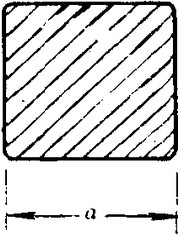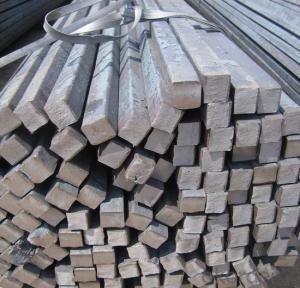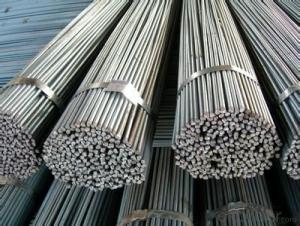High Quality GB Standard Steel Square Bar 21mm-25mm
- Loading Port:
- Tianjin
- Payment Terms:
- TT OR LC
- Min Order Qty:
- 25 m.t
- Supply Capability:
- 10000 m.t/month
OKorder Service Pledge
OKorder Financial Service
You Might Also Like
Product Description:
-Standard: GB,
-Grade: Q195 or equivalent.
-Chemical Composition:
Standard | Grade | Element (%) | ||||
GB | Q195 | C | Mn | S | P | Si |
0.06~0.12 | 0.25~0.50 | ≤0.050 | ≤0.045 | ≤0.30 | ||
Measures of HR Square Bar (small measures):

(Section of HR Square Bar)
-Length of a side and Theoretical weight of Square Bar.
Length of a side(mm) | Theoretical weight(kg/m) | Length of a side(mm) | Theoretical weight(kg/m) |
7 | 0.385 | 22 | 3.80 |
8 | 0.502 | 24 | 4.52 |
9 | 0.636 | 25 | 4.91 |
10 | 0.785 | 26 | 5.30 |
11 | 0.950 | 28 | 6.15 |
12 | 1.13 | 30 | 7.06 |
13 | 1.33 | 32 | 8.04 |
14 | 1.54 | 34 | 9.07 |
15 | 1.77 | 36 | 10.17 |
16 | 2.01 | 38 | 11.24 |
17 | 2.27 | 40 | 12.56 |
18 | 2.54 | 42 | 13.85 |
19 | 2.82 | 45 | 15.90 |
20 | 3.14 | 48 | 18.09 |
21 | 3.46 | 50 | 19.63 |
Notes:
1, The theoretical weights in the list, base on the density of 7.85 g/cm3.
2, Formula for theoretical weight of Square bar: (length of a side)2 * 0.00785
3, The numbers with *mean that they are not regular or we don’t offer them.
-Regular length of Square Bar:
Steel | Length of a side (mm) | Length of steel (m) |
Normal steel | < 25 | 4~10 |
> 25 | 3~9 | |
Steel of high quality | All measure | 2~6 |
Tool steel >75 | 1~6 |
Usage/Applications of HR Square Bar:
-The Square Bar is normally used as structure steel.
-Row material for other structure steel like steel angles, channels, I-beams, H-beams, etc…
Packaging & Delivery of HR Square Bar:
-Packing Detail: The products can be packed in bundles by steel wires.
-Marks: We make tag marks and color marks. The tag marks with white background and red company logo will be tied up to each bundle of the products. The information is usually including basic information of products and company and other information requested by customers. As for color marks, we will paint both ends of bundles to make sure that it will be more convenient for customers to distinguish them from other products.
-Delivery Detail: 30~45 working days after receive buyer’s T.T. or L/C.
Transportation:
-The products can be delivered by bulk vessel or by container. As for container, products with the length of 6m will be loaded in 20’ container, with 9m or 12m, in 40’ container.
-The maximum quantity of loading of container is 25 tons.
-The products are usually transported to the nearest port from the production place.
- Q:How do you use a steel square for marking stair nosing angles?
- To accurately mark the angles for stair nosings, a steel square is the tool of choice. Here's a step-by-step guide: 1. Begin by measuring the width of the stair nosing and indicating it on the steel square. Measure from the nosing's edge to where it meets the tread. 2. Align the marked width on the steel square with the nosing's edge, making sure the square is perpendicular to the nosing. 3. Determine the desired angle for the nosing, which can be based on the stair design or architectural plans. For instance, a common angle is 90 degrees. 4. Locate the corresponding angle on the steel square. Typically, the square will have a range of angle markings, such as 45 degrees, 60 degrees, 90 degrees, etc. Align the square's edge with the desired angle marking. 5. With the steel square properly aligned with the desired angle, proceed to mark the nosing using the square's edge. This will provide a precise and accurate angle for the nosing. 6. Repeat this marking process for each stair nosing, ensuring that the steel square is correctly aligned each time. By utilizing a steel square, you can effortlessly and precisely mark the angles for stair nosings, resulting in a professional and accurate installation.
- Q:How do you use a steel square to determine the angle of a valley rafter cut?
- To use a steel square to determine the angle of a valley rafter cut, you would first place the square on the edge of the rafter and align one arm with the top edge of the rafter. Then, you would pivot the square until the other arm aligns with the bottom edge of the rafter. The angle indicated on the square where the bottom edge intersects is the angle of the valley rafter cut.
- Q:Can a steel square be used for setting up a planer?
- Yes, a steel square can be used for setting up a planer. A steel square is a versatile tool commonly used in woodworking and carpentry to ensure accuracy and precision in various tasks, including the setup of machinery such as a planer. When setting up a planer, a steel square can be used to check the alignment of the tables, fences, and blades, ensuring that they are all perfectly square and parallel. This is important for achieving smooth and accurate planing results. Additionally, a steel square can also be used to check the squareness of the workpiece before planing, helping to ensure that it is properly aligned and will be planed evenly. Overall, a steel square is a valuable tool that can definitely be used for setting up a planer and ensuring its optimal performance.
- Q:What are some common uses for a steel square in woodworking?
- Some common uses for a steel square in woodworking include marking and measuring right angles, checking for squareness, laying out and transferring measurements, and guiding saw cuts.
- Q:How do you use a steel square to mark a line parallel to a board edge at a specific distance?
- To use a steel square to mark a line parallel to a board edge at a specific distance, place the square against the edge of the board and align the desired measurement on the square's blade. Then, draw a line along the edge of the blade to mark the parallel line at the specified distance.
- Q:How do you choose the right size of steel square?
- When choosing the right size of steel square, consider the scale and complexity of the project you are working on. Smaller squares, such as 6 or 12 inches, work well for smaller tasks and intricate measurements, while larger squares, such as 24 or 48 inches, are better suited for larger projects that require longer and more accurate measurements. Additionally, consider the weight and maneuverability of the square, as a heavy or bulky square may be difficult to handle. Ultimately, the right size of steel square will depend on the specific requirements of your project and your personal comfort and preference.
- Q:What are some common techniques for using a steel square in stair building?
- Some common techniques for using a steel square in stair building include measuring and marking the rise and run of each step, determining the angle of the cuts for stringers, and ensuring the steps are level and square by using the square as a guide. Additionally, the square can be used to check the levelness of the landing and to ensure that the stair treads and risers are cut accurately.
- Q:Can a steel square be used for tile corner layout?
- Yes, a steel square can be used for tile corner layout. A steel square, also known as a framing square or carpenter's square, is a versatile tool that can be used for a variety of layout tasks, including tile corner layout. The right-angle shape of the steel square makes it ideal for ensuring precise and accurate corners when laying tiles. By placing the steel square against the corner of the tiles, you can make sure they are properly aligned and square to each other. This is particularly useful when working with large tiles or when creating intricate tile patterns where precise corner alignment is crucial.
- Q:Can a steel square be used for checking the plumbness of columns?
- No, a steel square cannot be used for checking the plumbness of columns. A steel square, also known as a framing square, is a tool primarily used in carpentry and woodworking for measuring and marking right angles. It is not designed or calibrated for vertical alignment or determining the plumbness of objects such as columns. To check the plumbness of columns, a plumb bob or a level would be more suitable tools. A plumb bob is a pointed weight that hangs from a string, allowing for precise vertical alignment. By observing the position of the plumb bob in relation to the column, one can determine if it is perfectly plumb or if any adjustments need to be made. Alternatively, a level can also be used to check the plumbness of columns. A level is a tool with a liquid-filled tube and a bubble that indicates whether a surface is level or plumb. By placing the level against the column and observing the position of the bubble, one can determine if the column is perfectly vertical or if any adjustments are required.
- Q:Can a steel square be used for measuring door and window openings?
- A steel square, also called a framing square or carpenter's square, is a versatile tool widely employed in construction and carpentry. It is capable of measuring door and window openings accurately. This tool typically possesses a 90-degree angle and a lengthier blade, which serves the purpose of measuring and marking straight lines. Additionally, the shorter blade can be utilized for measuring various angles, including 45 degrees or 30 degrees. To ensure precise and square measurements, a steel square can be utilized when measuring door and window openings. By placing it against the edges of the opening, one can determine if they are perfectly perpendicular or if any adjustments are necessary. The width and height of the opening can be measured using the longer blade, while the shorter blade serves to verify if the corners are square. In conclusion, a steel square is a dependable tool that can be used to measure door and window openings, guaranteeing their proper alignment and squareness.
1. Manufacturer Overview |
|
|---|---|
| Location | |
| Year Established | |
| Annual Output Value | |
| Main Markets | |
| Company Certifications | |
2. Manufacturer Certificates |
|
|---|---|
| a) Certification Name | |
| Range | |
| Reference | |
| Validity Period | |
3. Manufacturer Capability |
|
|---|---|
| a)Trade Capacity | |
| Nearest Port | |
| Export Percentage | |
| No.of Employees in Trade Department | |
| Language Spoken: | |
| b)Factory Information | |
| Factory Size: | |
| No. of Production Lines | |
| Contract Manufacturing | |
| Product Price Range | |
Send your message to us
High Quality GB Standard Steel Square Bar 21mm-25mm
- Loading Port:
- Tianjin
- Payment Terms:
- TT OR LC
- Min Order Qty:
- 25 m.t
- Supply Capability:
- 10000 m.t/month
OKorder Service Pledge
OKorder Financial Service
Similar products
New products
Hot products
Related keywords



























